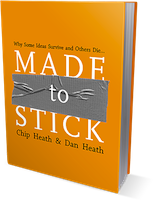Chip and Dan Heath in ‘Made to Stick’ helps us to understand why so many urban myths have survived for thousands of years and yet we struggle to communicate or remember information that is vital for our own success. Sticky ideas follow a pattern which has been summarised in six principles.

Malcolm Gladwell in his book ‘Tipping Point’ used the phrase ‘The Stickiness factor” to explain why some ideas and product innovations are more likely to spread and thrive.
Both books make great read and from made to stick here are 6 factors that can make your idea, product or headline stick:
#1. Simple
If you can say it with two words, say it with two and not twenty. If your organisation stands for many things, no one will know what you stand for. To stand for one thing means you must know what you do not stand for. Be a master of exclusion and learn to say no with a smile.
Simple according to Dan and Chip Heath simple is not dumbing down. Simply answer the what one thing question and the express it in as few words as possible.
The ultimate model of simplicity: one sentence statement so profound that an individual could spend a lifetime learning to follow it ~ Made to Stick
#2. Unexpected
Stories stick if they contain an unexpected twist. To get attention, you need to say or do something unexpected. State the unexpected.
#3. Concrete
You need to learn to live in the world of concretes and not abstract. The man in the yellow short sleeve shirt is more visible that the same man with a light coloured shirt. Express your ideas in with word pictures than can be seen and felt. Follow this link for a list of fuzzy words that will not do your idea any good. Vivid and concrete images allow ideas to easily cling to memory
#4. Credible
If people do not believe you then they will not remember your message. Since few people will bother to challenge your statement, the credibility must be contained in the idea. This allows your audience to test the validity of your claim in their mind before choosing to accept it. Dan sites the example of president Ronald Reagan who did rather than use statistics simply asked voters to judge for themselves if they were better off today than they were four years earlier.
#5. Emotion
An appeal to the emotions is always a recipe for success. People will think with their head but act from the heart. In public speaking, it is said that people my not remember what you said, but will certainly remember how you made them feel. Ideas that exploit the emotions of greed, fear and disgust tend to be remembered more.
#6. Stories
We remember stories more than statistics. To get people to act on your idea, tell stories of how others have acted on it and had results. We all love a good story which has a simple plot, contains unexpected twists, expressed in a language that helps us feel see and touch it, is relatable and credible an appeals to our emotions.
Made to Stick is full of ideas, anecdotes and illustrations about products and ideas that stick. Reading this book will help you make your ideas and products stick in the minds of others.
Why not leave a comment if you have read Made to Stick.
